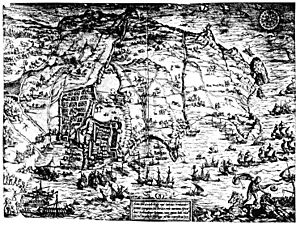Capture of Béjaïa (1510) facts for kids
Quick facts for kids Capture of Béjaïa |
|||||||
|---|---|---|---|---|---|---|---|
| Part of Spanish campaigns in the Maghreb (1497–1535) | |||||||
|
|||||||
| Belligerents | |||||||
| Commanders and leaders | |||||||
| Abdelaziz Hafsi | Pedro Navarro | ||||||
| Strength | |||||||
| 10,000 men | 5,000 men 13 ships |
||||||
| Casualties and losses | |||||||
| 300 dead 200 captured |
Unknown | ||||||
The capture of Béjaïa was a battle where the Spanish Empire took control of the city of Béjaïa. Béjaïa was also known as Bougie. At that time, it was an emirate, which is like a small kingdom, ruled by a group called the Hafsid dynasty. This event happened in 1510. The Spanish lost the city 45 years later in 1555 to Salah Rais and the Kingdom of Kuku.
Why Béjaïa Was Important
Béjaïa was a busy and important city. According to a traveler named Leo the African, the city had an old wall around it. It also had colleges where people studied law and math. There were mosques, markets (called souks), and hospitals. About 8,000 families lived there.
The Spanish Plan
In the late 1400s, many Muslims were forced to leave Spain by the Catholic Monarchs. These Muslims found new homes in cities along the coast of North Africa. These cities included Oran, Algiers, and Béjaïa.
From these coastal cities, they started to organize attacks at sea. These attackers were known as corsairs. They bothered Spanish ships and hurt their trade. In Béjaïa, the ruler, Sultan Abdelaziz, stopped the special trading rights that merchants from Catalonia (a region in Spain) had since 1473. He also sent help to the rulers of Mers el-Kébir and Oran when the Spanish attacked them.
In 1509, after taking the city of Oran, Cardinal Cisneros gave a task to Pedro Navarro. Navarro was told to capture other places along the Algerian coast that the corsairs used. So, Navarro sailed towards Béjaïa on January 1, 1510. His ships reached the city on January 5. The details of the battle that followed are told differently by Spanish and Arab sources.
See also
 In Spanish: Conquista de Bugía (1510) para niños
In Spanish: Conquista de Bugía (1510) para niños


